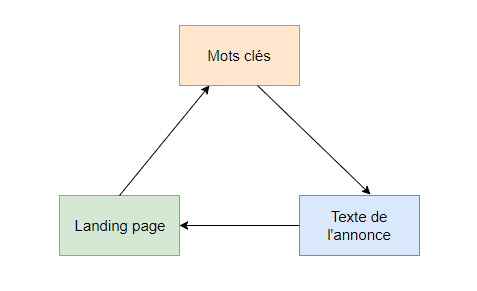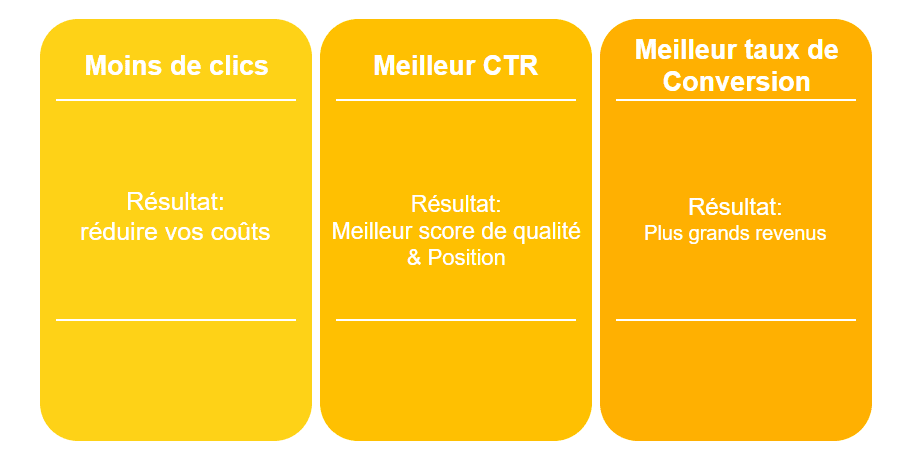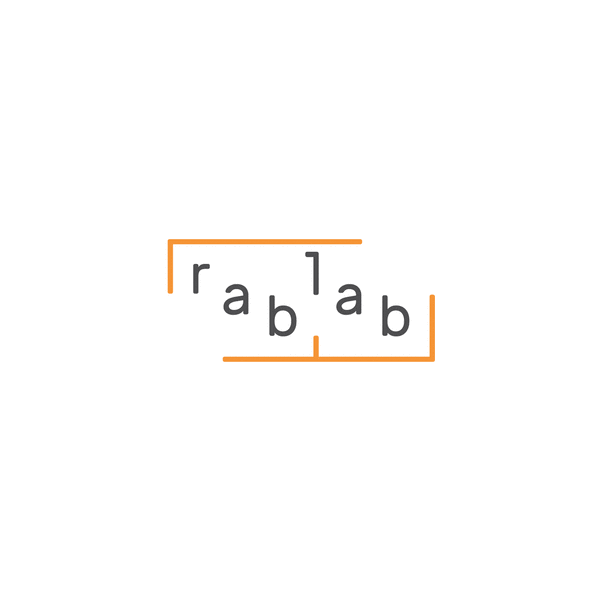How to save money on Google AdWords? Here are the 8 tips to follow !
Do you want to generate more qualified leads on your website? Pay-per-click (PPC) marketing is a great way to do that. When a PPC campaign is well executed, it can be a great way to increase conversions and revenue. Your products or services will appear at the top of the first page of Google (or Bing) on the searches you deem relevant.
However, because you pay for every click on your ads, a poorly managed PPC campaign can cost much more than it brings in. There are some basic tactics that work consistently to avoid slippage.
Here are 8 of the most important, but often forgotten, elements of PPC campaign optimization. Some are more advanced than others, but if you use our tips in your PPC campaigns, you should see a big improvement and generate more money!
1. MAKE YOUR LANDING PAGE RELEVANT
The ultimate goal of PPC marketing is to make a sale (or a lead), not just to get a click.
Successful PPC ads generates qualified leads to a landing page. That landing page must then be expected to convert the visit into a paying customer. So it’s critical to optimize your landing pages for PPC conversions by aligning the message of your ads with the message of your landing page.

Consistency between your keywords, your ads and your landing pages should improve your click-through rates and conversions while lowering your CPC.
Try as much as possible to repeat everything that is said in your ad on your landing page. You know your customers are interested in the offer, you can increase conversions by presenting the same message and call to action (CTA) on your landing page.
By following this rule of thumb, you will have more compelling ads that will help your customers understand your ad and, in turn, generate more conversions.
2. OPTIMIZE NEGATIVE KEYWORDS!
One of the most powerful tools at your disposal to ensure the quality of your AdWords campaign is to optimize the keywords to exclude. AdWords allows you to target keywords that are more or less related to your product or service. This way, your ads will not come up if the search contains the negative keyword and it will help you save a lot of money.

For example, one of my clients has a high-end condo project. Condos are not for the younger crowd and are not cheap. To make sure they received qualified traffic, I excluded keywords like “cheap”, “condo access” and many others to exclude traffic from people who were not in their demographic.
It’s just as important to inform Google of what your product and service are not as it is to notify them of what they are. Negative keywords can be added at the campaign level, but you can achieve this by adding unique keywords to specific ad groups if needed.
3. USE THE RIGHT MATCH TYPES!
When someone enters a search query into Google, AdWords displays ads based on the relevance of the bidding system to the search term and displays an ad accordingly.
The most essential part of a PPC campaign is the keywords you use and the match types you use for those words. There are four types:
Broad: This is the broadest and corresponds to searches with words in any order (including synonyms and neighbouring words) that include the targeted keyword.
Modified Broad Match: This type of match is less broad than pure broad and is represented by a (+) sign in front of your keywords. This modifier is similar to the broad match, but does not have synonyms and related words.
Phrase Match: The phrase match is a string of words in quotation marks. This modifier will display your ad only when the string of words is searched. Example: You use the keyword “pizzeria Montreal” and a person searches “pizzeria Montreal near me” you will appear.
Exact Match : ce mot clé est similaire au ”phrase match”, mais vos annonces ne s’afficheront qu’avec la recherche exacte. Ce modificateur est signifié en mettant votre mot-clé (s) entre parenthèses.

Each type of match is a compromise between impressions and relevance to each other.
If you want to get the most impressions, you should choose a broad match, but don’t do it for your AdWords marketing campaign. On the other hand, Exact Match will have fewer impressions, but should have a higher relevance and click-through rate.
4. ADJUST THE MATCH TYPES OVER TIME
Whenever I launch an AdWords campaign, I usually start with several ad groups with strong similar keyword themes. For the first 30 days of a campaign, I often use Modified Broad match types because they offer a good level of control for running my ads and also enough opportunity to collect data.
While I do a lot of research to understand the competition and the market before I run my ads, I find that the first month is a good time to learn firsthand about what people are looking for when it comes to my clients’ products and services.
PUBLICITY
After 30 days, I add various words in exact match, which will allow the best performing Broad Modifiers to stay and improve the relevance of my ads.
5. FILL IN ALL AVAILABLE AD CONTENT
Since their release in July 2016, extended text ads have had a massive impact on AdWords. By providing additional space for relevant content, ETAs provide PPC managers a great way to add some meat around the bone when describing a product or service.
If you want your ads to perform better, make sure you fill in all the available information fields.

Here’s an example:
Final URL: Unique and/or highly relevant landing page for your ad.
Headline 1: Include the brand name or proposition in this field.
Headline 2: Include a supporting value proposition here or use this field to set the context for the description.
Path 1: Place the location (city or state depending on the situation) or general category of the product/service.
Path 2: Try to include more specific information in this field to provide context.
Description: This is the section that ties your customer’s needs to your product or service. Include a strong call to action at the end of the description to further push your message and increase your conversions.
6. USE EVERY RELEVANT AD EXTENSION
Many AdWords PPC managers think that the value of PPC ends with the headlines, final URLs and description of the AdWords ad. However, ad extensions are a critical part of the customer experience and can give your ads a huge impact on performance.

Ad extensions can help you better differentiate your brand while offering valuable information to your customers.
There are several ad extensions to choose from, but the most significant ad extensions are:
Sitelinks: These are additional links that your customers will find useful to link directly to unique landing pages.
Callouts: Use these to build reader confidence by including entries such as “Fast Professional Service” or “Peace of Mind Guarantee”.
Structured snippets: Include them to provide more information about your offerings. They are based on specific categories. So you need to choose a category that is relevant to you.
Review: When you have your Google my business, adding these types of extensions can greatly increase engagement. Tip: Use your site reviews so that when your audience clicks on the extension, they are directed to your website.
7. ADJUST BIDS FOR GEOGRAPHIC TARGETING
Regardless of your market or industry, you can benefit by focusing your marketing investments on specific geographic locations.
Even if you provide digital products and services, you can benefit by looking at where your engagement is coming from to prioritize spending. However, industries like apartments, hotels and lawyers often qualify their ideal customer with proximity to their physical office.
If your products and services don’t depend on the physical location of your customers, you can still optimize your PPC campaigns with targeted bidding based on seasons, weather, and user needs.
You can save a lot of money by preventing ads from running in certain areas while increasing the likelihood of a conversion and increasing bids in locations that convert.
8. MOBILE-OPTIMIZED CAMPAIGNS
Many of your future customers use mobile devices. Mobile-optimized campaigns give you the best chance to engage your mobile customers in the right format on their preferred device. Separating campaigns is an easy way to generate more qualified clicks.
How do you determine if a campaign should have a mobile-only component? Look at conversions.
If mobile is generating a significant portion of conversions, I copy the existing campaign and exclude mobile on the first one. Similarly, I’ll exclude desktop in the new mobile campaign.
The CPC for mobile ads can be lower than for desktop-only campaigns. You can do mobile-only campaigns by focusing on click-to-call extensions.
GOOGLE ADWORDS IS AN INVESTMENT
A properly maintained PPC campaign can help business owners make a lot of money. As long as you make sure you take all available steps to optimize the overall experience and generate conversions.
Try out my suggestions for your PPC campaigns and you should be able to make your business more profitable with qualified traffic and increased sales.
We use the best analytics tools available on the market to grow your business. Web marketing has never been easier!

